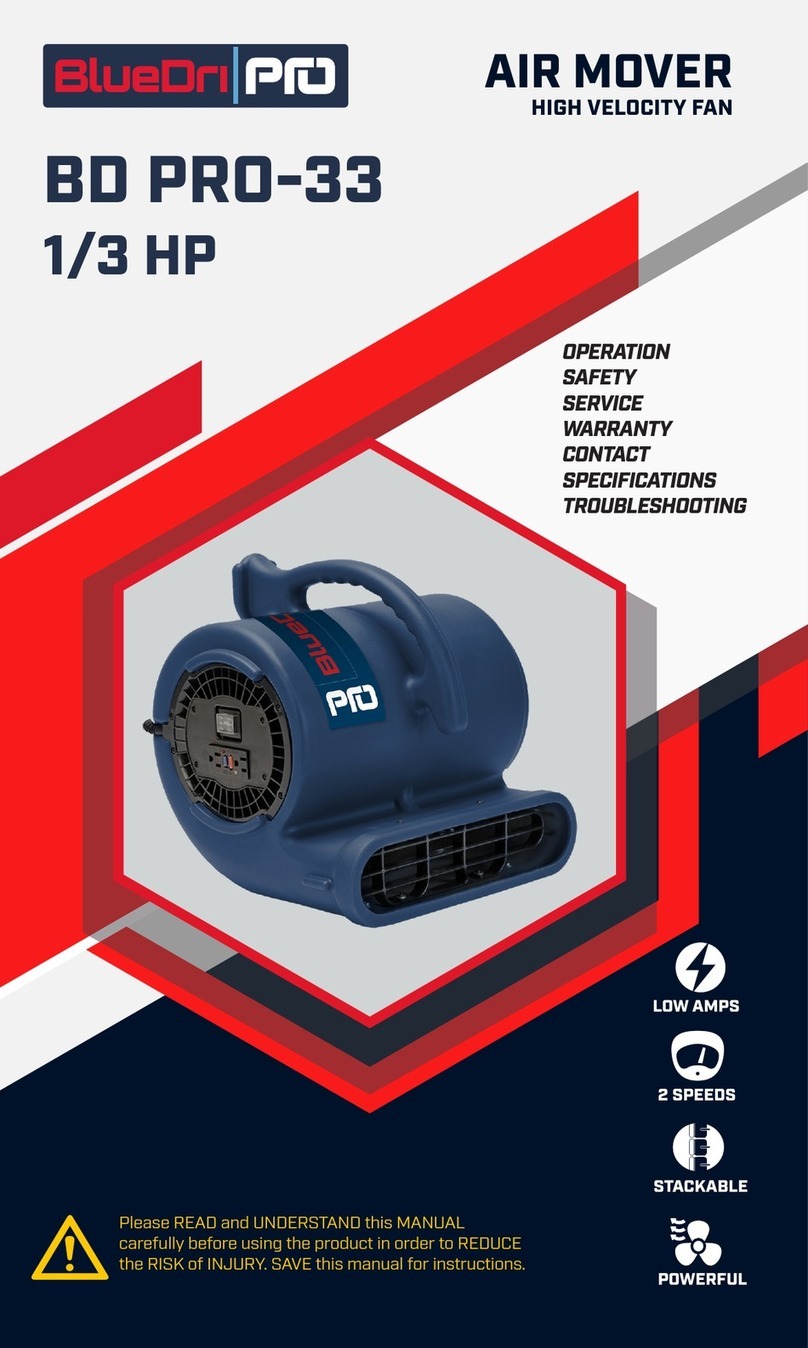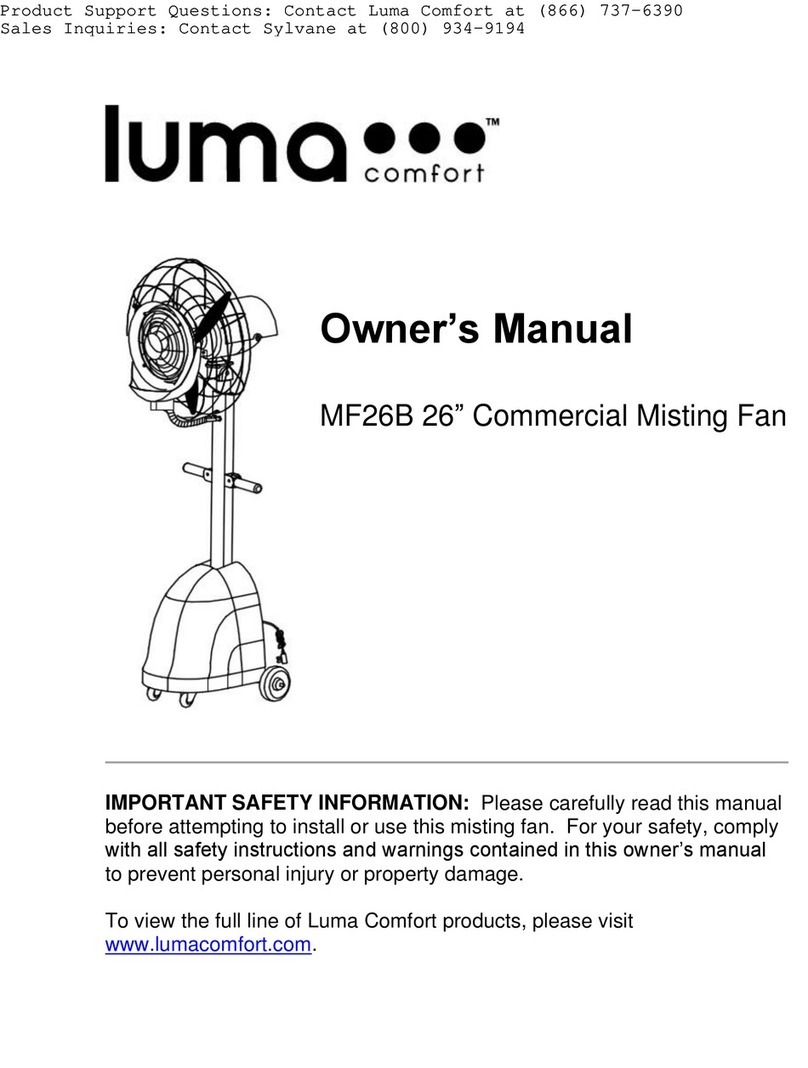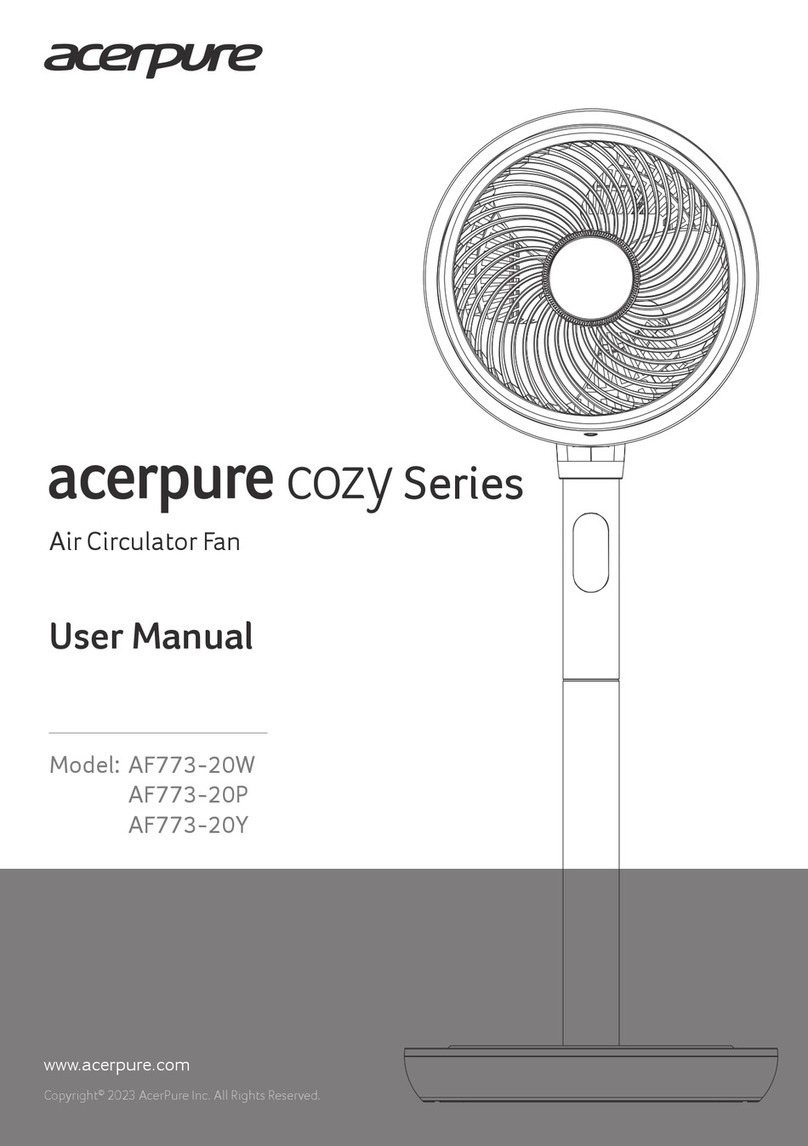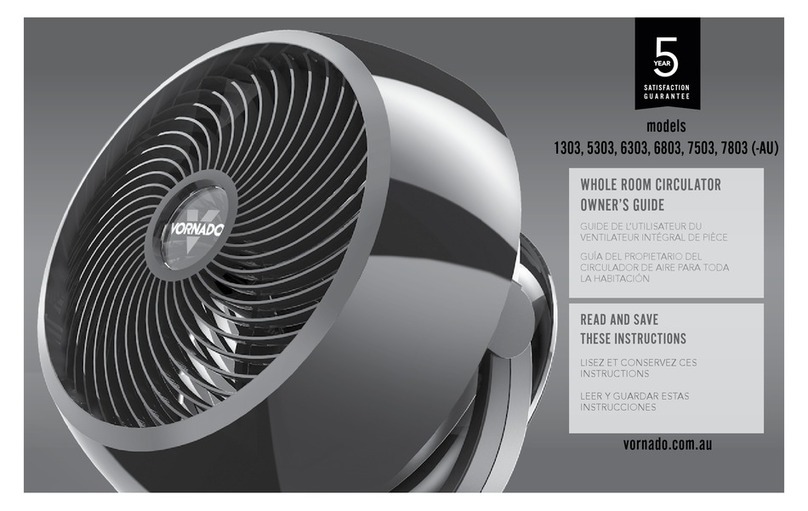Spitfire MA6720 AU series User manual

OWNER’S MANUAL
READ AND SAVE THESE INSTRUCTIONS
Model No. MA6720**AU
The Spitfire™
Ceiling Fan
Net Weight 00.0 kg (00.0 lbs)

Table of Contents
3.......................................snoitcurtsnIgnikcapnU
Energy Efficient Use of Ceiling Fans . . . . . . . . . . . . . . . . . . . . . . . . . . . .4
Electrical and Structural Requirements . . . . . . . . . . . . . . . . . . . . . . . . . .4
How to Hang This Ceiling Fan .. . . . . . . . . . . . . . . . . . . . . . . . . . . . . . . . .5
How to Wire This Ceiling Fan . . . . . . . . . . . . . . . . . . . . . . . . . . . . . . . . . .6
Installing the Canopy Housing . . . . . . . . . . . . . . . . . . . . . . . . . . . . . . . . .7
Mounting the Fan Blades . . . . . . . . . . . . . . . . . . . . . . . . . . . . . . . . . . . . . 7
Maintenance . . . . . . . . . . . . . . . . . . . . . . . . . . . . . . . . . . . . . . . . . . . . . . .
Blade Cleaning . . . . . . . . . . . . . . . . . . . . . . . . . . . . . . . . . . . . . . . . . . . . .
Parts List . . . . . . . . . . . . . . . . . . . . . . . . . . . . . . . . . . . . . . . . . . . . . . . . . 9
8
8
Exploded-View Illustration. . . . . . . . . . . . . . . . . . . . . . . . . . . . . . . . . . . .10
Trouble Shooting . . . . . . . . . . . . . . . . . . . . . . . . . . . . . . . . . . . . . . . . . . .11
Important Safety Instructions
WARNING: To avoid fire, shock and serious personal injury, follow these instructions.
1. Read your owner’s manual and safety information before installing your new fan. Review the accompanying assembly diagrams.
2. Before servicing or cleaning unit, switch power off at service panel and lock service panel disconnecting means to prevent power
from being switched on accidentally. When the service disconnecting means cannot be locked, securely fasten a warning device, such
as a tag, to the service panel.
3. Be careful of the fan and blades when cleaning, painting, or working near the fan. Always turn off the power to the ceiling fan before
servicing.
4. Do not insert anything into the fan blades while the fan is operating.
5. Do not operate reversing switch until fan blades have come to a complete stop.
Additional Safety Instructions
1. To avoid possible shock, be sure electricity is turned off at the fuse box before wiring, and do not operate fan without blades.
2. All wiring and installation procedures must comply with AS/NZS 3000 Wiring Rules and any local regulations. The ceiling fan
must be grounded as a precaution against possible electrical shock. Electrical installation must be made by a licensed electrician.
3. The fan base must be securely mounted and capable of reliably supporting at least 27kg. See page 4 of owner’s manual for support
requirements.
4. The fan must be mounted with the fan blades at least 2.1 meter from the floor to prevent accidental contact with the fan blades.
5. Follow the recommended instructions for the proper method of wiring this ceiling fan.
6. This fan is not suitable for use with solid state controllers.
WARNING: This product is designed to use only those parts supplied with this product and/or accessories designated specifically for
use with this product. Using parts and/or accessories not designated for use with this product will void your warranty and could result in
personal injury or property damage.
WARNING: To reduce the risk of personal injury, do not bend the blade bracket (flange or blade holder) when installing the brackets,
balancing the blades, or cleaning the fan. Do not insert foreign objects in between rotating fan blades.
WARNING:
This fan MUST be installed with an easily accessible isolating
device to disconnect all poles of the fan from the main supply.
The contact distance in all poles must be 3mm minimum.
6. Do not dispose of electrical appliances as unsorted municipal waste, use separate collection facilities.
7. Contact your local government for information regarding the collection systems available.
8. If electrical appliances are disposed of in landfills or dumps, hazardous substances can leak into the groundwater and get into the
food chain, damaging your health and well-being.
9. This appliance is not intended for use by persons (including children) with reduced physical, sensory or mental capabilities, or lack
of experience and knowledge, unless they have been given supervision or instruction concerning use of the appliance by a person
responsible for their safety.
10. Children should be supervised to ensure that they do not play with the appliance.

This manual is designed to make it as easy as possible
to assemble, install, operate, and maintain this ceiling fan
Unpacking Instructions
For your convenience, check-off each step. As each step is completed, place a check mark. This will ensure that all
steps have been completed and will be helpful in finding your place should you be interrupted.
Wiring and connectors must be of type required by
local regulations. The minimum wire would be a 3-
conductor (2-wire with ground).
Tools Needed for Assembly Materials
NOTE: If you are uncertain of part description, refer to
exploded view illustration. (Figure 1, page 10)
3
1. Check to see that you have received the following
parts:
• Fan Motor Assembly
• Downrod
• Hanger Bracket
Assembly
Blade Plate•
Magnet•
Wall Control•
Speed Capacitor•
• One Phillips head screwdriver
(supplied)
• One stepladder
• One small blade
screwdriver
• One wire stripper
• Hardware bags:
▲
WARNING
Do not install or use fan if any part is damaged or
missing. This product is designed to use only those
parts supplied with this product and/or any accessories
designated specifically for use with this product.
Substitution of parts or accessories not designated
for use with this product could result in personal injury
or property damage.
IF ANY PART IS DAMAGED OR MISSING,
CALL: 13 00 46 9 326
▲
WARNING
This fan must be installed by a licensed electrician.
Hardware Bags
– 1/4-20 mm Screw
– Flat Washer Ø12 x Ø6.5 mm
– Phillips screwdriver, 10 cm
– Allen Wrench 3/32˝x 56 mm
Hanger Bracket
Assembly
Blade Plate
Wall ControlSpeed Capacitor
Magnet
Fan Motor Assembly
Downrod
−#8-32 x 1.5˝ Pan Head Screws
−Ø14 x Ø5.5 mm Flat Washers
−#4.5 External Tooth Washer
−Spring Washer M4.5
−Hex Washer Phillips Head Tapping
Screws M6-10 x 2˝

This new ceiling fan will require a grounded electrical supply
line of 230 volts AC, 50 Hz circuit. The hanger bracket
must be securely anchored and capable of supporting
a load of least 27kg. If your fan is to replace an existing
ceiling light fixture, turn electricity off at the main fuse
box at this time and remove the existing light fixture.
Figure 1 depicts a typical structural configuration that may
be used for securely mounting the fan.
4
▲
WARNING
Turning off wall switch is not sufficient. To avoid
possible electrical shock, be sure electricity is turned
off at the main fuse box before wiring. All wiring must
be in accordance with AS/NZS 3000 “The Wiring Rules”
and the ceiling fan must be properly grounded as a
precaution against possible electrical shock.
▲
WARNING
This fan must be installed by a licensed electrician.
Electrical and Structural Requirements
snaFgnilieCfoesUtneiciffEygrenE
Ceiling fan performance and energy savings rely
heavily on the proper installation and use of the ceiling
fan. Here are a few tips to ensure efficient product
performance.
Choosing the Appropriate Mounting Location
Ceiling fans should be installed, or mounted, in the middle
of the room and at least 2.1 m above the floor and 50 cm
from the walls. If ceiling height allows, install the fan
2.4-2.7 m above the floor for optimal airflow.
Turn Off When Not in the Room
Ceiling fans cool people, not rooms. If the room is
unoccupied, turn off the ceiling fan to save energy.
Using the Ceiling Fan Year Round
Summer Season: Use the ceiling fan in the counter-
clockwise direction. The airflow produced by the ceiling
fan creates a wind-chill effect, making you “feel” cooler.
Select a fan speed that provides a comfortable breeze,
lower speeds consume less energy.
Winter Season: Reverse the motor and operate the ceiling
fan at low speed in the clockwise direction. This produces
a gentle updraft, which forces warm air near the ceiling
down into the occupied space. Remember to adjust your
air conditioner when using your ceiling fan-additional energy
and dollar savings could be realized with this simple step!
Ceiling
Ceiling
Joists
Ceiling
Joists
Figure 1
50 X 100 mm
Timber Batten
Between Joists

5
How to Hang This Ceiling Fan
WARNING
The fan must be hung with at least 2.1m of
clearance from floor to blades. (Figure 2)
WARNING
Failure to seat tab in groove could cause damage to
electrical wires and possible shock or fire hazard.
WARNING
To avoid possible shock, do not pinch wires between
the hanger ball assembly and the hanger bracket.
WARNING
To avoid possible fire or shock, be sure electricity is
turned off at the main fuse box before wiring.
(Figure 1)
Figure 2
CEILING
FLOOR
Figure 4
Figure 3
Figure 1
MAIN FUSE BOX
Motor Assembly
2. Carefully lift the motor assembly on the hanger
bracket that was just attached to the timber batten.
Be sure the groove in the ball is lined up with tab on
the hanger bracket (Figure 4).
NO
LESS THAN
2.1 M
Hanger
Bracket
Note: Ceiling board and
wiring omitted for clarity.
Screw with hex head
screws(2) supplied with fan
Hanger
Bracket
Terminal Block
Tab
Note: Ceiling board and
wiring omitted for clarity.
Timber Batten
WARNING
The hanger bracket must be securely mounted and
capable of supporting at least 27 kg. If bracket and /or
timber batten are not securely attached, the fan could
wobble or fall.
1. Drill a hole in the ceiling board and batten for wiring
Securely attach the hanger bracket to a timber batten
or other structural support using appropriate fasteners.
(Figure 3).
Note: Before assemble the hanger bracket, please
remove both of terminal blocks. Reassemble the
terminal blocks when the hager bracket assembled
completed.

6
How to Wire This Ceiling Fan
WARNING
To avoid possible fire or shock, be sure electricity is
turned off at the main fuse box before wiring.
(Figure 1)
Figure 1
MAIN FUSE BOX
Figure 2
Figure 3
Ceiling fans must be installed by a licensed electrician.
▲
WARNING
Check to see that all connections are tight, including
earth, and that no bare wire is visible at the wire
connectors, except for the earth wire. Do not operate
fan until the blades are in place. Noise and motor damage
could result.
1. Securely connect the green/yellow earth wires from the
hanger ball and the hanger bracket and the supply
green/yellow earth wire to the terminal block as shown in
Figure 2.
2. Securely connect the blue fan motor wire and the black
supply neutral to the “N” terminal of the connector block
as shown in Figure 2.
3. Securely connect the brown fan motor wire and the red
(Active) supply wire to the “L” terminal of the connector
block as shown in Figure 2. After connections have been
made, carefully push leads into the recess making sure
there is separation between connectors.
INSTALLATION NOTE: If light fixture is NOT required,
terminate the orange light wire. If light fixture is required,
refer to documentation supplied with lighting fixture for
further instruction.
Installing Wall Control (Rotary) Switch
1. With electrical power still disconnected, install fan
switch control wiring to desired location on wall.
2. Ensure wiring connections are as shown in Fig 2. The
Active (Red) supply wire must be connected
to terminal "C" on the rotary switch. Return switched wire
to ceiling fan to be conected from terminal ˝1˝ on the rotary
switch to ˝L˝ terminal on the connector block.
3. Fit the wall control (rotary) switch to a face plate (not
supplied) and attach to wall.
INSTALLATION NOTE:The “O” and the small corner
cut-out on the front of the switch mechanism must be at
the top and top left respectively (See Figure 3).
IMPORTANT: Fan installation must be completed,
including the installation of the fan blades, before testing
of the controls.
4. Restore electrical power to the ceiling fan by turning
the electricity on at the main fuse box.
5. Check the operation of the fan by rotating the control
through the four positions marked 0 - III
(“0” position is OFF) (Figure 4).
6. All fans are shipped from the factory with the reverse
switch positioned to circulate air downward.
If airflow is desired in opposite direction, turn your fan
OFF and wait for the blades to stop turning,
then slide the reversing switch to the opposite position,
and turn fan on again.
Terminal Block
(on Hanger Bracket)
Supply Cable
Grn/YelWire
(Earth) from Hanger Bracket
Grn/Yel Wire
(Earth) from Fan
BlueWire
(Neutral)
OrangeWire
(Light Active)
BrownWire
(Motor Active)
3
2
1
C
Capacitor
Red
Purple
Brown
Rotary Switch Red Wire
(Active)
Red Wire
(Active)
Black Wire
(Neutral)
Grn/Yel Wire
(Earth)
NL1 L
Hanger Ball
Figure 4
= OFF = FAST = MED = SLOW

7
Mounting the Fan Blades
Installing the Canopy Housing
Figure 1
Figure 2
NOTE: This step is applicable after the neccessary wiring
is completed.
▲
WARNING
To avoid possible fire or shock, make sure that the
electrical wires are completely inside the canopy housing
and not pinched between the housing and the ceiling.
x 6
x 6
FLAT WASHER
1/4˝-20 mm
SCREWS
HARDWARE USED:
1. Remove one of the two shoulder screws in the
hanger bracket. Loosen the second shoulder screw
without fully removing it. Assemble canopy by
rotating key slot in canopy over shoulder screw in
hanger bracket. Tighten shoulder screw. Fully
assemble and tighten second shoulder screw that
was previously removed. (Figure 1)
2. Securely attach and tighten the canopy screw cover
over the shoulder screws in the hanger bracket
utilizing the keyslot twist-lock feature. (Figrue 2)
Do not connect fan blades until the fan is completely
installed. Installing the fan with blades assembled
may result in damage to the fan blades.
CAUTION
1. Secure the three blades using the 1/4˝-20 mm
screws with flat washers and blade plate through the holes
located on the bottom of the motor assembly. (Figure 1)
Figure 1
1/4˝-20 mm
Blade Plate
Motor Assembly
Screw and Flat Washer
(2 each per blade)
Blade
(not included)
NOTE: The blades not included.

Maintenance
Periodic cleaning of your new ceiling fan is the only
maintenance that is needed.
When cleaning, use only a soft brush or lint free cloth to
avoid scratching the finish.
Abrasive cleaning agents are not required and should be
avoided to prevent damage to finish.
CAUTION
Do not use water when cleaning your ceiling fan. It
could damage the motor or the blades and create the
possibility of electrical shock.
Blade Cleaning
Periodic light dusting of the blades is recommended. Avoid using water, cleansers, or harsh rags, which can
warp and ruin the blades.
NOTE: The trim cover not included.
8
Mounting the Fan Blades (continued)
Motor Assembly
Magnet
Figure 2
2. Place the magnet at the bottom center of the motor
assembly. Position the trim cover onto the magnet.
(Figure 2)
Trim Cover
(not included)

Before discarding packaging materials, be certain all parts have been removed
Parts List
Model MAFP6720**AU
Ref. # Description Part #
1 Hanger Bracket Assembly with Screws
2 Downrod
3 Motor Assembly
3a
3b
3c
3d
Ball Downrod Assembly
Canopy
Canopy Screw Cover Assembly
Motor Coupler Cover Assembly
8
Hardware Bag Containing:
Allen Wrench 3/32˝ x 56 mm
How To Order Parts
When ordering repair parts, always
give the following information:
For repair parts:
Phone 1300 469 326
• Part Number
• Part Description
• Fan Model Number
Insert FINISH CODES (Refer to fan model number located on downrod support)
APGAC112R-220
DR1-9**
AMA6720**AU
ADRAC1-45**AU
P672001**
APPAC1101**
Blade Plate
4P672008NI
Magnet
5P672010NI
Wall Control
6SAA4
Speed Capacitor
7CAP042017-450AU
HDWMAFP6720AU
AP672002**
3e Motor Housing Assembly AP6720**AU
9
Ø12 x Ø6.5 mm Flat Washers (7)
Phillips Screwdriver, 10 cm
Blade Mounting Hardware Bag Containing:
˝–20 mm Screws (7)
Hanger Bracket Mounting Hardware Bag Containing:
#8-32 x 1.5˝ Pan Head Screws (2)
Ø14 x Ø5.5 mm Flat Washers (2)
#4.5 External Tooth Washer (2)
Spring Washer M4.5 (2)
Hex Washer Phillips Head Tapping Screws M6-10 x 2˝ (2)
1/4

Model MAFP6720**AU Exploded-View
NOTE: The illustration shown is not to scale or its actual configuration may vary.
Product/parts are subject to change without notice.
Figure 1
3
3a
3b
3c
3d
8
8
10
1
2
4
5
6
7
3e
™
The Spitfire

Trouble Shooting
For your own safety, turn off power at fuse box or circuit breaker before trouble shooting your fan.
Some suggested remedies require the attention of a licensed electrician.
WARNING
!
Trouble Probable Cause Suggested Remedy
1.FAN WILL
NOT START
1. Check main and branch circuit fuses
or circuit breakers.
2. Check line wire connections to fan
and switch wire connections in the
switch housings.
CAUTION: Make sure main power is
turned off !
1. Fuse or circuit breaker blown.
2. Loose power line connections to the
fan, or loose switch wire connections
in the switch housing.
2.FAN SOUNDS NOISY
1. Attach blades to fan before operating.
2. Check to make sure all screws in
motor housing are snug (not over-
tight).
3. Check to make sure the screws which
attach the fan blade to the motor
assembly are tight.
3. Check to make sure the screws which
attach the fan blade to the motor
assembly are tight.
CAUTION: Make sure main power is
turned off !
4. Tighten set screw securely.
1. Blades not attached to fan.
2. Loose screws in motor housing.
3. Screws securing fan blade to motor
assembly are loose.
3. Screws securing fan blade to motor
assembly are loose.
4. Lower housing support set screw
loose.
3.FAN WOBBLES
EXCESSIVELY
1. Tighten both setscrews securely in
downrod support.
2. Tighten the setscrew in the downrod/
hanger ball assembly.
4. Tighten the hanger bracket screws to
the timber batten, and secure outlet
box.
1. Setscrew in downrod support is loose.
2. Setscrew in downrod/hanger ball
assembly is loose.
4. Hanger bracket and/or ceiling timber
batten is not securely fastened.
1. Typically, airflow can be increased by
lowering fan blades further from
ceiling using a longer downrod.
4.NOT ENOUGH AIR
MOVEMENT
1. If possible, consider using a longer
downrod. Please be aware that blades
must be at least 2.1 m above floor
level.
11

2014/09 V.01
Table of contents

















